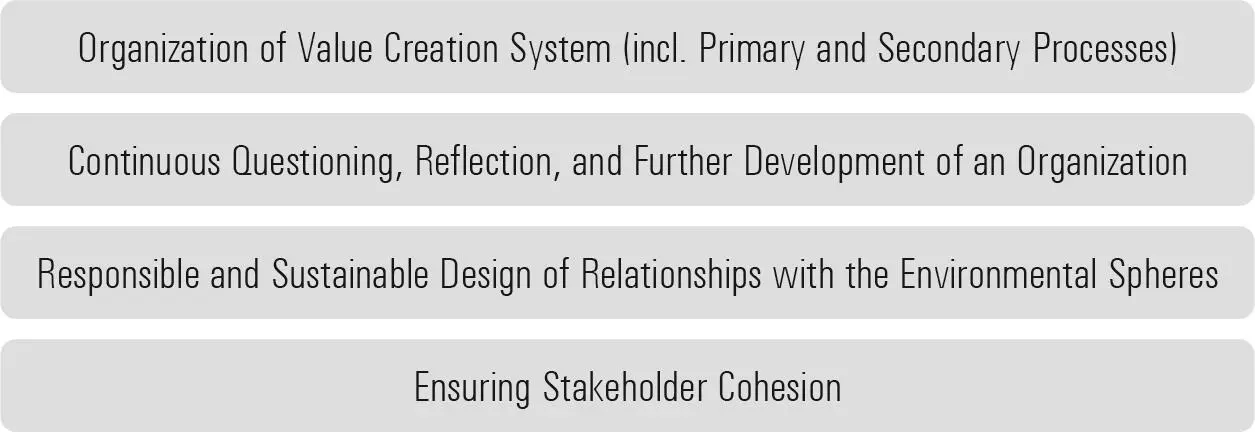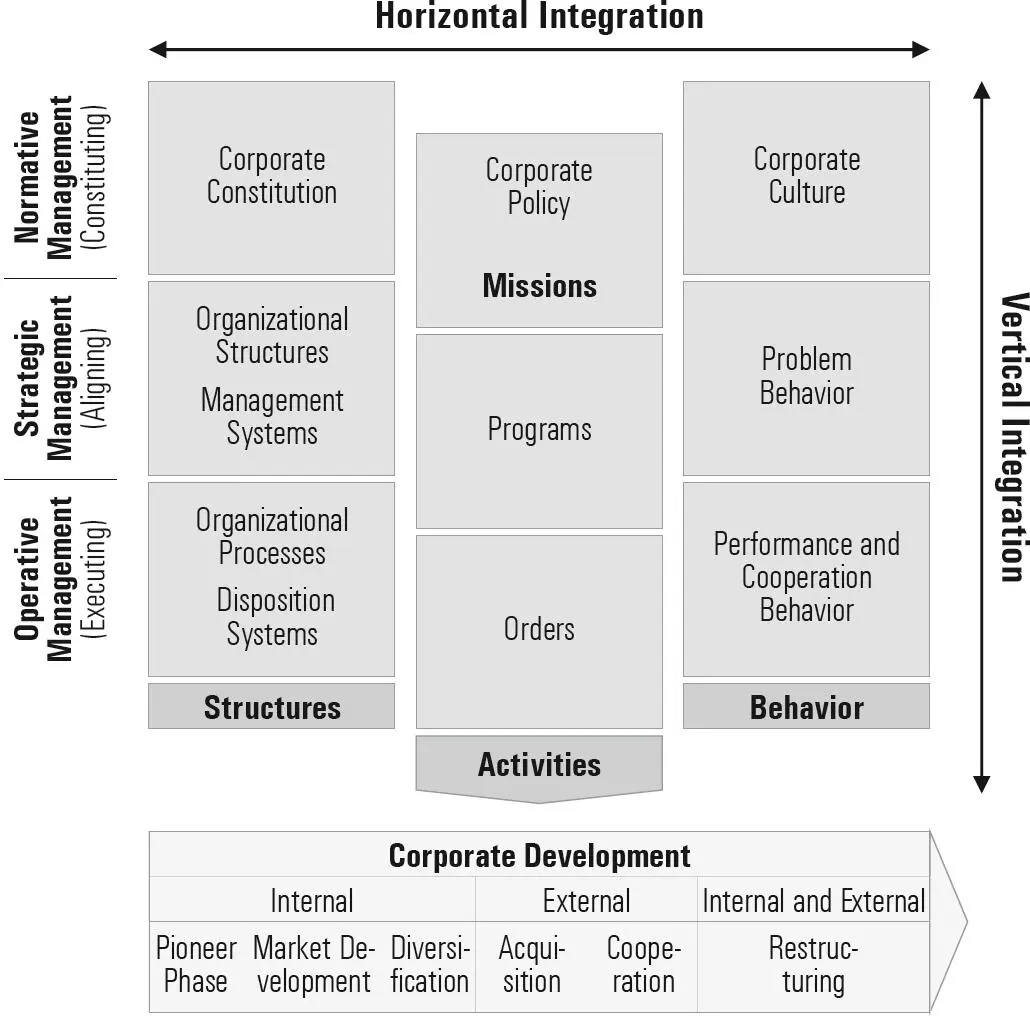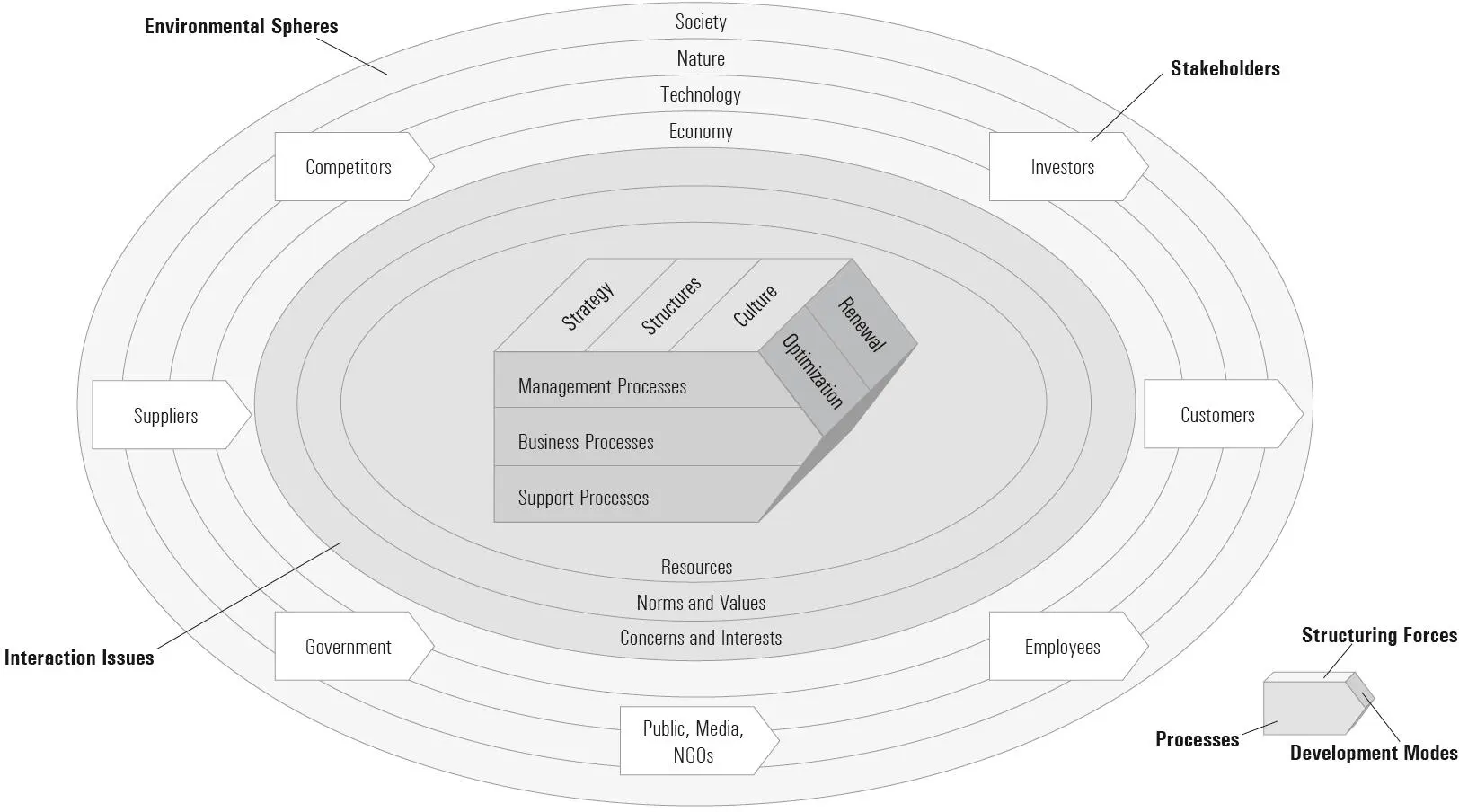– A strategy (see Section 3.2) can be designed only if an organization’s long-term pupose is clear. A sports infrastructure facility, for example, needs to determine whether it is a health or a leisure company. This decision defines the fields in which a strategy is searched for (e.g., identifying new products). The purpose of strategy is to ensure competitiveness. To this end, strategic success factors are developed either within (“inside out,” e.g. core competencies) or outside the company (“outside in,” e.g. market positionings).
– An organization’s structure (see Section 4.2) must be aligned with the strategic success factors according to which the organization needs to define its processes and to design its strategy to optimally support those processes (Osterloh & Frost, 1996). If, for example, a company defines its ability to adapt service processes as optimally as possible to customer needs as its central strategic success position, it will focus on customer-oriented service processes. Consequently, the organization will need to align itself according to customer groups as its primary ordering criterion, possibly by defining its main departments according to customer groups.
– [22] Structure and culture correlate (see Section 4.6). For example, a strong hierarchical organization results in a culture of control, which in turn impacts the organization’s functioning. The culture, in turn, must be consistent or at least compatible with the company’s purpose.
These considerations, and the logic of the SGMM, lead to several basic management tasks that every organization must fulfill (Figure 1-2).

Figure 1-2: Basic Tasks of Management
Source: adapted from Rüegg-Stürm and Grand (2020)
1.3 Development of the St. Gallen Management Models
The latest version of the SGMM (introduced here) continues a 50-year tradition of systematically developing management at the University of St. Gallen. This began with the aspiration to create an “empty” framework in which to create meaning (Ulrich & Krieg, 1972). This framework (or “scaffold”) as such provides a structure for classifying problems and thus facilitates discussion. Like every model, it is a simplified representation of reality that needs to be concretized for the corresponding purpose.
1.3.1 First-Generation SGMM
[23] Already the first-generation SGMM, developed in the early 1970s, was guided by the idea of an open-minded approach to problems rather than a recipe-like imparting of knowledge (Ulrich & Krieg, 1972, p. 9). The model was based on systems-oriented business studies, which conceptualized companies as systems. The authors described systems thinking as holistic, process-oriented, interdisciplinary, analytical, synthetic, and pragmatic thinking (Ulrich & Krieg, 1972). Their approach took integrative thinking into account, while facilitating a cross-functional and cross-subdisciplinary approach to practical issues.

Figure 1-3: First-Generation SGMM: Management Model, Environmental Model, Company Model
Source: Ulrich and Krieg (1972, pp. 20, 27, 31)
[24] The first-generation SGMM has three parts: the company model, the environmental model, and the management model (Figure 1-3). The aim was to support management by representing the enterprise both as a productive and as a technical system, and by providing a tool for its analysis.
In the company model, the following five approaches were analyzed in more detail (Ulrich & Krieg, 1972):
– The company’s environment (stakeholders, environmental spheres)
– Markets and market performance (procurement and sales markets, resources and market performance)
– Functional areas (execution area, supply area, management area)
– Design levels (technological, economic, social)
– Structuring of tasks: repetitive and innovative tasks (preservation and renewal).
The environmental model with the environmental spheres and stakeholders is still part of the current SGMM.
In the field of corporate management (management model), three classification criteria were used (Ulrich & Krieg, 1972):
– Management levels (corporate politics, planning, disposition)
– Management phases (goals, means, processes)
– Management functions (deciding, initiating, controlling)
These structuring approaches recurred similarly in the subsequent generations of the SGMM. Over time, the model was repeatedly adapted to current findings in business studies and to management challenges.
1.3.2 Second-Generation SGMM
Bleicher (1991) titled the second-generation SGMM “The Concept of Integrated Management.” He highlighted Ulrich and Krieg’s (1972) holistic approach and explicitly addressed integrated management. The second-generation SGMM thus claimed to meet the requirements of a paradigm shift toward an understanding of management that consciously deals with increased complexity and the dynamics involved (Bleicher, 1991, p. 147). In the early 1990s, a new world order became foreseeable, following the collapse of the former Soviet system and [25] of centrally planned economies, as well as important technological innovations, for example, in the IT sector. Thus, the second-generation SGMM introduced the system levels discussed at that time (Schwaninger, 1988): the normative, strategic, and operational dimensions (Figure 1-4).

Figure 1-4: Second-Generation SGMM: Normative, Strategic, Operational Levels of the Organization
Source: Bleicher (1991)
1.3.3 Third-Generation SGMM
Rüegg-Stürm (2003) developed the third-generation SGMM as part of a curriculum redesign of business studies at the University of St. Gallen. His model served as the basis for an introductory textbook on business studies (Dubs, Euler, & Rüegg-Stürm, 2004, p. 8). Essentially, the key topics corresponded to the dimensions identified in the first-generation SGMM (Figure 1-5):
– [26] Environmental spheres
– Stakeholders
– Interaction issues (resources, norms, values, concerns, and interests)
– Structuring forces (strategy, structure, culture)
– Development modes (optimization, renewal)
In line with recent findings in business studies (see also Porter, 1985; Osterloh & Frost, 1996), these dimensions were supplemented by a process-oriented view. This replaced the functional view and distinguished business processes, management processes, and support processes, as well emphasized the importance of communication for performing management tasks.

Figure 1-5: Key Visualization of the Third-Generation SGMM
Source: Rüegg-Stürm (2003, p. 22)
1.3.4 Fourth-Generation SGMM
[27] Rüegg-Stürm and Grand (2017) conceived the fourth-generation SGMM as a renewed attempt to develop a language for reflecting on, discussing, and dealing with the complexity facing management practice (Rüegg-Stürm & Grand, 2017, p. 2). They defined management as a reflective design practice aimed at supporting entrepreneurial tasks and challenges. The fourth-generation SGMM complements the third generation’s process orientation by highlighting systematic reflection and ongoing enactment as core management tasks. The main reason for this emphasis is the increasing complexity, uncertainty, and dynamics of today’s world. These factors require organizations and their managers to incorporate the expected consequences of their own actions into their decision-making, which is subject to great uncertainty today.
Читать дальше
















